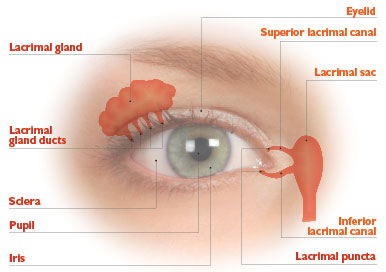What is dry eye disease and how will I know if I have it?
Dry eye disease, also known as keratoconjunctivitis sicca (KCS), can be a painful and irritating condition due to irregularities of the eye’s tear film. This can happen for a variety of reasons.
What causes dry eyes?
Aging:
As we get older, tear production decreases.
Contact lens wear:
Increases tear evaporation leading to irritation, redness and discomfort.
Hormonal changes in women:
Pregnancy, birth control pills, or menopause can cause dry eye symptoms.
Environmental factors:
Smoke, air pollution, air conditioning, wind, or cold, dry air can lead to KCS.
Effects of disease/medications:
Auto-immune diseases such as arthritis or lupus can lead to KCS. Medications to treat hypertension and other medical conditions can lead to dry eyes.
How common is dry eye?
Approximately sixty million people worldwide use artificial tears. It is estimated that close to five million people over the age of 50 suffer from chronic dry eye disease in the United States.
What are tears made of?
The pre-corneal tear film is comprised of three layers: the oily layer, the mucin layer and the watery layer. Any imbalance in the ratio of these three components can cause symptoms of dry eye disease.
What are some of the symptoms of dry eye disease?
Some of these symptoms include a dry, gritty feeling in the eyes that is often accompanied by burning and redness. Other symptoms can include sensitivity to light, heat or air conditioning, and discomfort when wearing contact lenses. If left untreated, the delicate tissue of the ocular surface can be damaged, leading to poor vision. The onset of dry eye may be a result of hormonal changes or inflammation of the surface of the eye or the glands that produce tears.
How does keeping my eye moist help me?
In a normally functioning eye, there is an anti-inflammatory component of the tears that keeps irritation to a minimum. When a component of tears is lacking and irritation is not controlled, the eye does not produce adequate tears. This causes the body’s immune system to activate a defense mechanism which leads to inflammation. This inflammation of the eye’s surface and the tear glands results in “abnormal” tears, and the common symptoms of dry eye. Since the tears are “imbalanced,” the irritated eye is not properly nourished or lubricated. This encourages the cycle of inflammation and dry eye symptoms to continue.
The tear film also has antibacterial function, and a lack of tears can increase the possibility of infection.
If my eyes tear, how can they be dry?
Eyes are lubricated by two types of tears; lubricating tears and reflex tears. Lubricating tears are produced continuously to moisturize the eye and contain infection-fighting compounds.
Reflex tears are produced in response to sudden irritation (smoke, dryness, irritation) or emotion. Ironically the irritated, dry eye causes reflex tears to flood the eye. Since reflex tears do not have the proper ratio of components of lubricating tears, the discomfort persists.
How can dry eye be detected?
Dry eye disease can be detected by a thorough medical history, examining whether a patient has environmental influences that may cause dry eyes such as excessive air conditioning or heating, a smoke filled environment, or spending a lot of time in front of the computer, television or reading. Several tests in the examination room are also very helpful in the diagnosis. These include Schirmer tests, slit-lamp examination and staining of the corneal tissue and tear film.
What treatments are available for chronic dry eye disease?
There are several ways to treat dryness in the eyes taking into consideration its intensity.
The first step would be to use lubricating tears, warm compresses, and lubricating ointments.
It is important to highlight the importance of a balanced diet and proper hydration. Our body is a clear reflection of the nutrients we intake. Our eyes do get affected by our daily diet.
Punctual plugs. These microscopic devices block the exit of tears from the surface of the eye, thereby creating a more humid environment. The procedure to insert the plugs is quick, painless, and reversible.
Cyclosporine (Restasis and Xiidra). These topical emulsions help treat the inflammatory changes that accompany dry eyes. Allowing you to produce more of your own tears.
Omega-3 fatty Acids. These Acids help your eyes in three simple ways. First, it helps reduce inflammation in the eye caused by dry eyes condition. Secondly, it helps to produce more of the oily layer produced by the meibomian glands. This allows for a better flow and creates a better oil layer covering the tear film. And thirdly, it stimulates tear production.
The Rand Eye Institute is proud to introduce specialty dry eye consultation appointments. Our Physicians will address all your concerns with dry eyes. One of the new options we have, at Rand Eye Institute, is the introduction of Lipiflow Thermal Pulsation System.
LIPIFLOW
Lipiflow is a relaxing procedure offered in our office. It is an very efficient way to restore your gland functions. This technology uses single-use applicators that applies heat and light pressure to extract gland contents and any obstructions to re-activate the eye’s natural oil production. This treatment addresses the cause of dryness in the eye rather that just treating the symptoms.
The health of your eyes is important. Our Physicians will perform a series of diagnostic tests to evaluate gland performance, as well as, the health of the glands. This will help determine the cause of your dry eye symptoms. At Rand Eye Institute we have the technology to treat the uncomfortable and irritating condition that you are experiencing. Give us a call for a Dry Eye Evaluation

